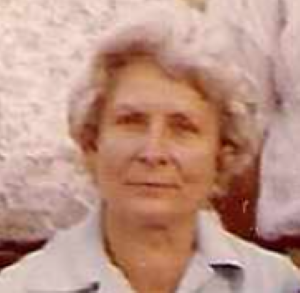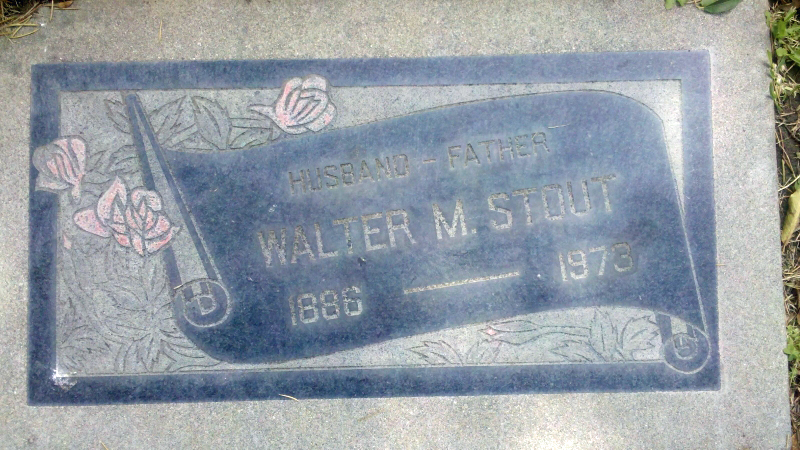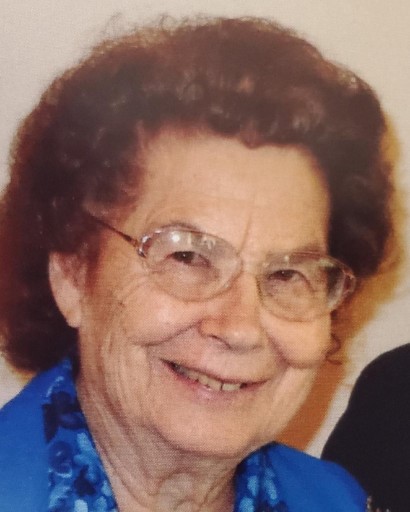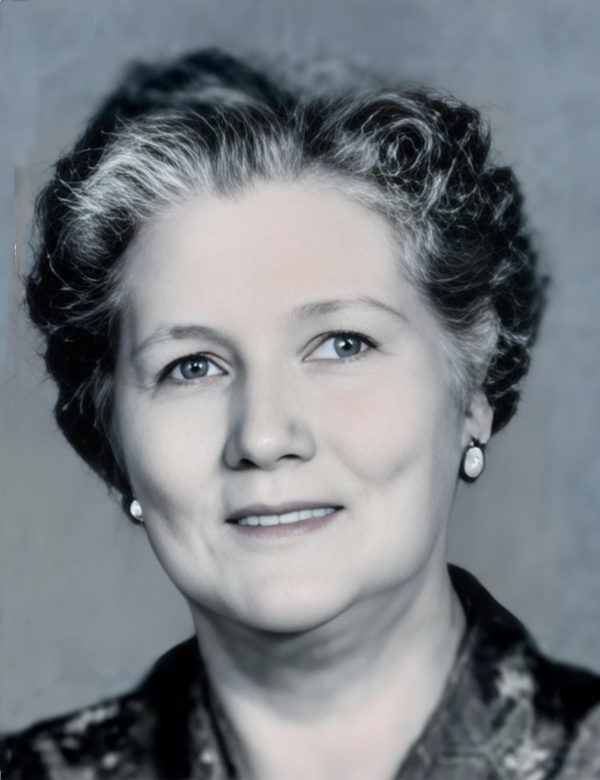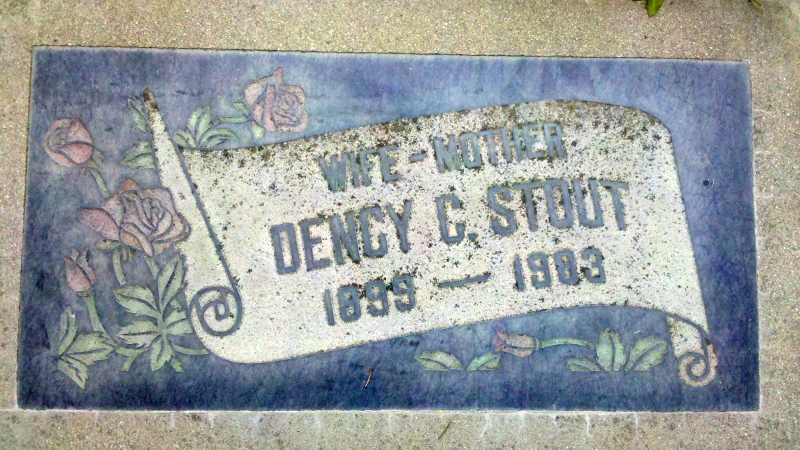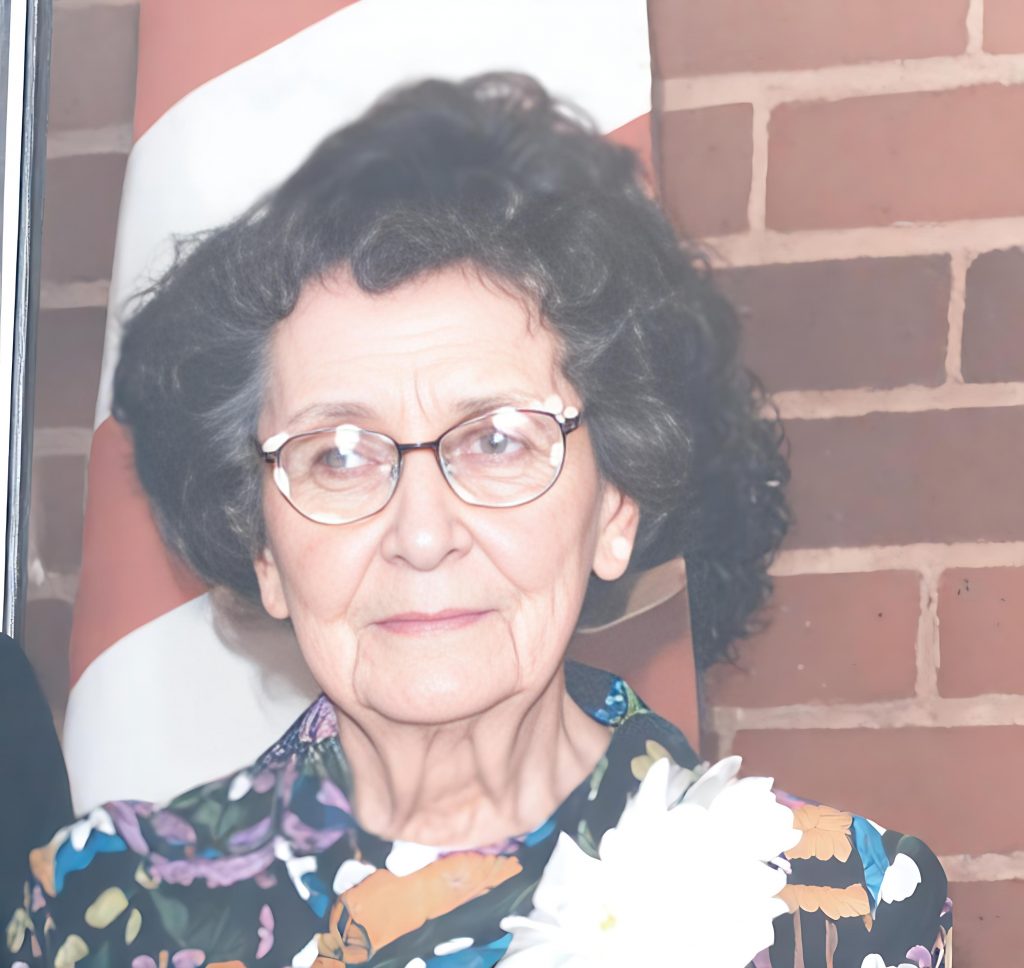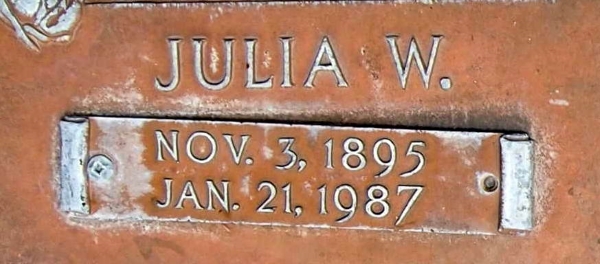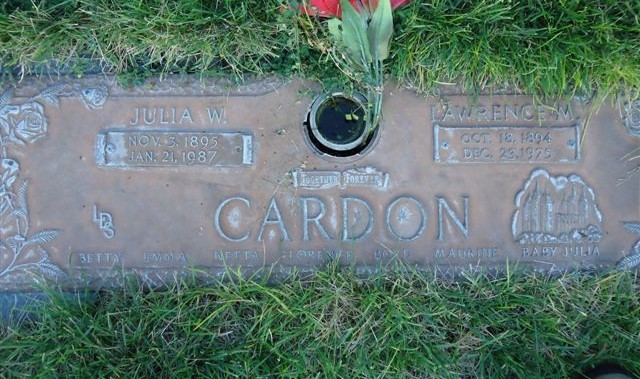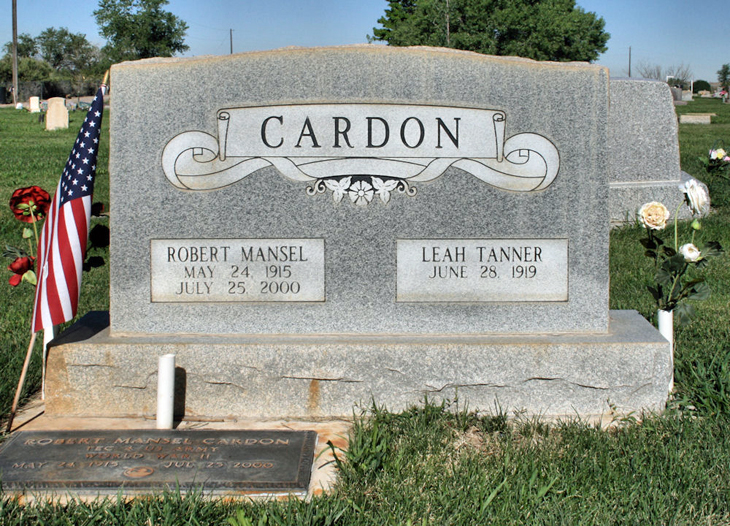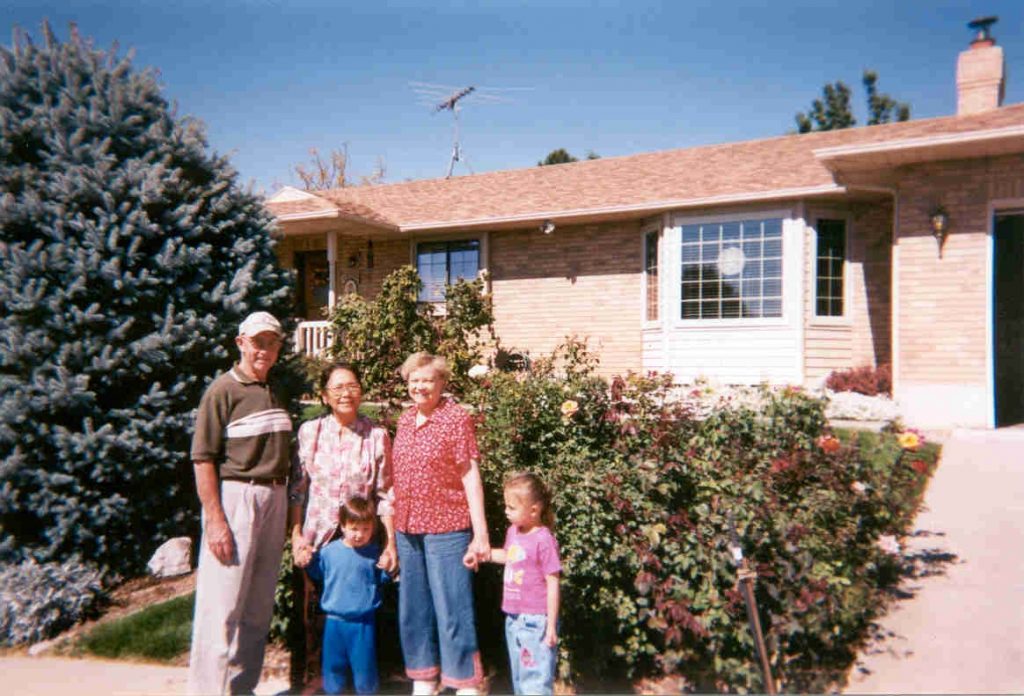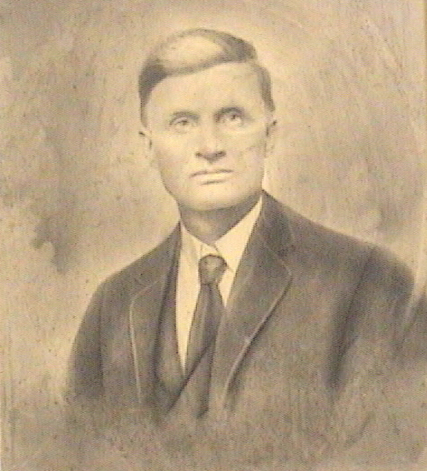28 Nov 1886 – 18 Mar 1973
Husband of Dency Cardon
MR. STOUT
Walter Milton Stout, 86, of 941 East 9th St., Upland, March 18 at San Antonio Community Hospital. A retired blacksmith, he was a native of Lemington (Leamington), Utah and an Upland resident 10 years. Member of Church of Jesus Christ of Latter-day Saints. Survived by his widow, Dency C. Stout, Upland: five sons, Archie L. Stout, of Mesa, Ariz., Marwood M. Stout of Upland, Alden C. Stout of Beaumont, Texas, Nathan L. Stout of Henderson, Nev., and Phillip D. Stout of Upland; five daughters, Mrs. W. R. Clark of Boulder City, Nev., Mrs. Harold White of Cucamonga, Mrs. Steve Chubs of Boulder City, Nev., Mrs. Verne Mauchley of Clearfield, Utah, and Mrs. John Carattini of Upland; a sister, Mrs. Lydia Bradshaw, Bell; 56 grandchildren and 29 great-grandchildren. Services Thursday, 10 a.m. at Church of Jesus Christ of Latter-day Saints, Upland. Bishop Marwood Stout, conducting. Interment Bellevue Cemetery. Stone Funeral Home in charge. Friends may call Wednesday from 5 to 9 p.m.
-Published in The Daily Report, Ontario-Upland, Calif., Tues., Mar. 20, 1973, page A-4
A Short Sketch of My Life
by Walter M. Stout
I was born in Leamington, Millard County, Utah, Nov 28, 1886, of goodly parents. My father was born on April 27, 1856, in Salt Lake City, Utah. He died of pneumonia Mar 31, 1889, in Mammoth, Juab Co, Utah. His name was Lewis Wilson.
He was the first constable also the first Ward Clerk in Leamington.
My Mother was Amanda Melvina Fisk Stout. They were cousins. She was born in Pleasant Grove, Utah Co. Utah, January 15, 1861.
In 1892 she was sent by the Leamington Ward to Salt Lake City to study under Dr Shipp to be a Mid-wife. She waited on all the women for every child that was born in Leamington from about 1893 to 1906 or 7. She died on June 28, 1916, at Leamington, and was buried there.
She was always active in Church work, was president of the YWMIA around 1900, was a Sunday School teacher, and an active member of the Relief Society.
My first duty in the church was President of the Deacons Quorum We had the responsibility of cleaning the schoolhouse where we held church. This resulted in me having to do it myself mostly.
I graduated from eighth grade in 1906 with my sister Lydia and Alma Harder.
In Feb 1910 Alma Harder and I were sent by the M.I.A. To take a course in the Deseret Gymnasium in connection with Scout work.
I became the first Scout Master and organized the first basketball team and registered the first scout troop in Leamington.
June 12, 1913, I married Martha Elizabeth Hansen of Abraham Millard Co, Utah, in the Salt Lake Temple.
My brother and I married sisters. We planned a double wedding, but Lewis was in the Central States Mission and was late getting in.
Maren and John Alvey, Martha’s sister and husband were going through with us and being sealed etc. So, Martha and I went through and were married on the 12 and went through with Maren and John on the 13.
Lewis arrived in time to go through but it being Friday the 13 and the 1913, Lottie would not be married on that day. So, we waited until the next Wed, the 18th and we all went through together. We always called it a double wedding.
Walter Douglas was born on May 4, 1914. Archie Leon was born Sept 6, 1915, and Agnes was born March 17, 1917, however, my mother died June 28, 1916, as stated above.
Sometime in the fall of 1916 I built a little house south of Leamington to homestead some land. Agnes was born out there.
May 23, 1917, Martha and I went down to Abraham to visit her folks, while there little Douglas took down with acute pneumonia and died May 26, 1917. Martha died June 15, 1917. This is a sad day. While Martha was lying in state at the old farmhouse, we all went over to Sam and Dorotha Jensen’s for supper and while there little Virginia, Dorotha’s oldest child was drowned in the canal back of the house. I have given a more detailed account of this sad event in my story (Gethsemane) and see also my poem (a short sketch of my life.)
May 18, 1919, I married Dency Cardon, daughter of Emanuel Alonzo Cardon and Rose Violate Terry, in the Saint George, Temple. We lived in the old Die Dutson home there in Leamington.
Oct. 22, 1919, I went on my mission to the Southern states. Marwood was born while I was out there on June 25, 1920. I returned Aug 31, 1921and went to work on the R.R., on September 1, 1921, for Charley Nelson who was the section boss. I didn’t fill the regular 2-year mission because my wife was in ill health.
Nobody knew what she went through while I was away. Our Bishop, Rodney B. Ashby advised my release.
May 18, 19122, Cardon was born, He came before the Dr. arrived.
March 23, 1923, Melvina and Rosina were born. We had Dr. Banning from Lynndyl, he was there on time.
Sept 1924, I bought a blacksmith shop in Hinckley, Millard Co. Utah, and my brother Lew moved the family down Sept 5, 1924.
I sold my home in Leamington to Joseph Overson for $800.00 and bought the blacksmith shop from Bishop Charles A. Stratton.
Feb 18, 1926, Gwen and Glen Allen were born in Hinckley, Jan 5, 1927, Nathan Lewis was born in Hinckley.
Jan 31, 1929, Belva Ann was born in Hinckley.
In 1929 the panic hit the country, the farmers were hard bit and things were tough.
I invented a ditch cleaner which was successful, but the farmers were too hard hit, I had to give it up.
In Sept. 1929 I went out to Kimberly Nevada with Inthus Parker. I got a job in the Nevada Con., in the Richard mine.
Jan 15, 1931, Lawrence Kenyon was born in Hinckley while I was still in Kimberly.
The panic was still on, and all the mines shut down July 8, 1931, I was laid off and went home.
I bought a home in Hinckley from June Black. My oldest sister (Mattie) and her husband, Arthur Cody Smith, were visiting in Leamington. I saw them on the 4th of July for the first time in 31 years.
They were returning to Mesa Arizona VIA Las Vegas Nevada, and I went with them.
At St. George we picked Vera our sister and went over to Panaca where our sister Lydia Bradshaw lived. We had a family reunion; all were there but Lewis. He was living in Oak City, Millard Co, Utah was very sick, not expected to live long, (but he did).
We went on to Las Vegas and I went out to the Boulder Dam project and got a job the first day I rustled July 18, 1931.
My family was still in Hinckley. Phillip Darryl was born Sept 24, 1932, in Hinckley. (Read my story Oasis in the Desert).
The family lived in Hinckley until Dec. 20, 1935, they moved to Boulder City.
All together including the time I spent on my mission and in Kimberly I spent 8 1/2 yrs away from my family, this was a hard life for both of us. My dear wife suffered greatly during those years especially while I was on my mission. She has suffered much but has stood by me giving full support in all my labors and duties and I praise her great name, she will be greatly blessed both here and hereafter.
October 12, 1939, Dency Lee was born in Boulder City, she is the only child born out of Utah.
Nov 2, 1948, Glen Allen was killed on the highway near Livermore, California.
I worked 3 ½ years high scaling, 3 years in the steel yard, 8 years on drainage in the dam and 11 years at the city disposal plant.
The positions I held in the church in Boulder City were first chairman of Genealogical committee about Oct 1932.
I was sustained as second counselor to President Lawrence Wortley, Mar 31, 1935. I held that position until Jan 24, 1937, when I was released and sustained as Ward Clerk. I held that position for 13 years.
I served under Wortley, Clifford Knewson, Dudley M. Leavitt and R, Owen Gibson. I also worked on the Sunday School Stake Board in 1952-53.
I have several hobbies in life, 1st Poetry. I began while on my Mission in 1920 also, while I was at Kimberly. 2nd Music, I began that while working at the Disposal Plant.
In 1946 I got interested in Book of Mormon Geography. I published a book which I called Harmony in Book of Mormon Geography in 1950. It created quite a sensation, it being the only setting to pinpoint locations to make the setting and narrative jive and provoke us to the exact working of the context.
It brings order out of chaos and provokes good logical, rational thinking. It is a peculiar thing but nevertheless true that we can misquote the Book of Mormon by the yard, and it will not be detected in matters concerning the geography, or pinpointing the setting. My setting has never been impeached by quoting the context correctly.
Nov 28, 1956, I turned 70 years old and was retired by the Civil Service Commission with an income of $126 dollars per month.
May 30, I went to Salt Lake and worked in the Temple. I stayed with Conrad and Viola Vogal. Dency was still in Boulder City.
July 8, 1957, I started to work at The Deseret Industries.
We gave our home in Boulder City to my boy Phillip and my wife moved to Salt Lake.
We rented an apartment at 60 N. 2nd W. It was on the 3rd floor and Dency couldn’t take it so we moved to the corner of the 4th West and North Temple.
July 11, 1957, my wife went to Pocatello and stayed with Rosina. I moved to 279 West on North Temple.
Jan 10, 1958, Dency came back from Pocatello, and we moved to 160 W. 7th So. We moved to 153 So 8th West, and again on June 16, 1958, we moved to 144 E 3600 S. I was transferred out to Sugar House as Loom mechanic, I worked there two years and went back to Deseret Industries. I first worked in the machine shop; I made up about 25 carts to push around. I did a lot of welding etc. When I came back from Sugar House I worked as a janitor and fired the boiler. I got a city license to fire the boiler.
May 14, 1960, we moved to Hunter and lived there until we move to Upland, California.
-Extracted from familysearch.org, ID KWCG-NMH
White-eye and the Snakes
This story takes place during the dark ages of my life and was a good lesson to me ever after. We were living in Leamington down on the farm. My brother Lew and I were trying in our weak way to put up the first crop of hay about 1905. We had brother MC Dutson helping us.
One evening some hunters from Eureka camped in our barnyard. They gave me a drink of whiskey mixed with port wine. While they were cooking a mélange stew with rabbit, duck, etc., in walked a team of mules on a wagon, we thought at first, they were alone, but a man was in the wagon a sleep. His mules had wandered away from the road he intended to travel.
His name was Frank Little from Nephi, going to Deep Creek, Nev. He was thirty miles off the road, so he camped there all night.
The water we used was out of a surface well and strangers did not like it. Mr. Little had a quart of White-eye which he put in the water adding sugar to it. He gave me a drink and it tasted good. I did not know that White-eye and Alcohol were the same although I had heard of both.
After supper they all sat around the fire telling stories. They set this bottle of white-eye behind them. Now the whiskey, wine and white-eye I had drank was calling for more, so I sneaked around and got that bottle and drank it straight.
I got about three good swallows and sat the bottle down and made for the well, it felt like my whole inside was on fire. I drank water and ate peaches and everything I could get hold of. I don’t remember all I did do but I know this, I never had anything in my life before or since that hurt me like that did. But I took it like a man never telling anyone about it.
When it quit burning, I decided to go to bed, I was not feeling very good.
Lew and I slept out under a shed, I got undressed all but my shoes and went to sleep.
Lew came along later and put me to bed right. Sometime in the night I woke up with the snakes, everything around had snakes all over it. I woke Lew up and showed him. He tried to explain to me that they were just plain harmless cedar posts.
Morning finally came, but what a morning, what I suffered that day no one knows, only those who have gone through it.
Bro. Dutson came to work, I did not eat I told Mother that I ate out with those hunters, I did not want her find out that I was drunk.
The hunters and Frank Little left and we went to work. We hauled a load or two. I worked or was supposed to work on the wagon loading while Lew and Cale Dutson pitched on, then I was supposed to run the derrick horse. I was not doing a good job and there was a considerable amount of contention between Lew and I, finally the contention became so sharp that he came down from the stack after me, I left my horse and took off around the haystack.
There was a tall picket fence around it with a blind alley, this I had not considered in my haste to safety. Upon finding myself trapped I looked for means of escape, not any, but I did find a weapon to defend myself, and old mower side with one section on the end resembling a tomahawk. I grabbed it and marched forward to battle.
My opponent was not armed so he retreated with me in hot pursuit. Arriving at point of beginning we found greater troubles than our own. My horse decided it was time to go to work and had pulled the hay pole down. The pole encountered the hay rack, and my horse was pulling the whole outfit, the hay pole wagon and team.
Brother Dutson was holding the team back to counteract my horse. This ended World War one. We straightened things out and went to work. It was the longest day I ever put in. Much more could be said, but I think my grandchildren will do well to read this much. It will give them a faint idea of their unworthy granddad.
June 21, 1947, Walter M. Stout
-Extracted from familysearch.org, ID KWCG-NMH
A Job by Keeping the Word of Wisdom
I went to work on the R.R. In Lynndyl, Utah in 1909 on the rip rap track. After working a week or so I got acquainted with the Blacksmith, who was in the boiler room of the roundhouse.
I had helped some and mentioned the fact to him saying, “I would like to work in here but I guess there is no chance of that.
About a week later the boss sent me into the Blacksmith Shop, in there I found two other helpers with a hammer each, as I entered, the blacksmith handed me one too.
We had a big square iron in the fire, it was a lug bar that coupled the engine and tender.
When it was hot he put it on the anvil and said “hit it. We stood in a circle hitting in turn.
This was before they got the steam hammer. The iron had to be drawn out three fourths of an inch, we hammered until the iron was cold. It took about 12 to 15 minutes.
This was repeated 3 or 4 times, then the blacksmith measured it, and we had drawn it out one eight of an inch. The next time we hammered until the iron was cold. One fellow threw his hammer full length of the boiler room and said, “To hell with that noise” and beat it out of there. The other fellow, who was the real helper, picked up that hammer and discarded the one he had. Then I noticed the difference between. I had the 19-pound hammer and die corded the one he had. They put another man on the extra hammer, and we went to work.
Before the day was over, they had changed men on those two hammers 7 or 8 times, while I stayed with the 19-pound hammer.
Next morning I went back to the rip rap track. At night the boss told me to report at the blacksmith shop in the morning, I went in and was told to go in the office, there filled out an application for blacksmith helper. Returning to the shop I found him waiting with a big iron in the fire and the hammer I used before was by the anvil. He put the hot iron on the anvil and told me to hit it. I hammered until the iron was cold. The shop was full of men, some were looking through windows, others were in the doorways. We heated and hammered that iron several times then he laid it aside for another job that just came in. We worked at different jobs; the blacksmith showed me how to make a fire with blacksmith coal.
I worked several days and began to get acquainted with the men around there and my work. Then one day the blacksmith offered me a drink of beer, which I refused. He said, “I thought something was wrong with you now I know there is. You don’t drink beer nor smoke.”
I had refused cigarettes also cigars. Then he told me all about it. The day I started to work I was on exhibition. It seems that I had built up some kind of a reputation that day when I used that 19# hammer against the men using the smaller hammers.
That iron I hammered on the first day was not good, they just used it for me to hammer on for an exhibition.
I could see through it myself after he told me, but he added, “It pays to take care of yourself”.
Well, it paid me five cents an hour more than I was getting, which was the big sum of .25an hour, Now I was getting .30. That was big money, skilled labor was getting 57 cents an hour.
The regular helper had taken 10 days off, when he came back, they sent him out in the machine shop, and he quit. I didn’t know that for some time after he was gone. After I had worked there a week or so, one of the machinists had a job where he and his helper had worked two days on the job where a large pin had frozen and broken off. The round house foreman took the blacksmith out to look at it, he said he could get it out, so the job was his.
He took me and my 19# hammer out there and we knocked that pin out in 45 minutes,
That started something, whenever those fellows got a job of the kind, he would send me out there to give them a lift and would add “They are to light in the lower end.”
I worked there until 1910 when they had a big strike, and I went out with them. I could stay and take over the blacksmith job, but I would not scab, as they called it.
Written June 1947, Walter M. Stout
-Extracted from familysearch.org, ID KWCG-NMH
Trains and Watermelons
This event happened during the dark ages of my life, yet I look back on it with a touch of humor, considering the things I did at this period of my life, it was very mild.
It is useless to say that a boy of my frame of mind would not be interested in watermelons.
One evening Carl Nielson, Heber Sorenson, and I rode up town. We had no object in view, but we found others who did. There were Fred and Wells Nielson, Alma Harder, Oxel Johnson and the most outstanding were Roy and Win Walker from Oak City, who were on their way to Eureka with a four horse load of watermelons, They were camped on the east side of a picket fence, on the east side of the lot which belonged to Joseph T. Finlinson.
We finally gathered around this spot and indulged in various kinds of sports. We were all enthusiastic because we figured in time the Walker boys would open up a melon or so.
They had asked us to stay up to meet the midnight train. We stayed willingly, but as time passed, we began to see that there would be no melons.
The R.R. Track was fifty yards away with a sidetrack, and the depot was fifty yards down from the crossing… there was a car loaded with hay near the crossing near the depot.
We tried every way to get both of the Walker boys in a race that would get them both away from their wagon, but nothing doing, one of them would stay at the wagon. I had a plan in mind as soon as the train came, I challenged all of them to ride the farthest and get off.
They all accepted it and had no opposition to the coveted melons.
I ran over and got three of the largest I could find and hid them down by the cattle chute. The boys were still out of sight, so I went for more. I made three successful trips and had 9 of the best melons in the world. (I didn’t realize that until I had gone to Boulder City)
I hid while the boys went by, then I ran down the track out of sight and came up the track and joined the rest. When they asked me how far I rode, I said “to Joe Nielson’s crossing.” It almost took their breath. Carl, Herb and I got on our horses and started home. As soon as we were alone, I asked them how many melons they got? Which brought forth comments about those fellows staying so close to their wagon. I said, I got nine all by myself. When I showed them and told my story, they had their doubts about me carrying three of them at once. So, I had to demonstrate. One under each arm one on my big belly holding it with both hands, I admit it takes practice. Now we were confronted with another problem of how to carry them on our horses. I solved that by taking off my overalls and putting a melon in each leg and one in the crotch and put them straddle of my horses neck. The others did the same and thus we went home rejoicing. (slap happy)
June of 1947 Walter M. Stout
-Extracted from familysearch.org, ID KWCG-NMH
My Gethsemane
This story covers a sacred period of my life, a time when I was put in the fiery furnace of life, to see what kind of metal I was made of.
It is an old story to say, I fell in love with a good girl and repented of my evil ways, As old as it is, it is new to those having that experience. I have to admit, it was the influence of my first wife that caused me to about face and try to make amends for my wasted wayward life.
Singing had a lot to do with it, in those days of the old saloon, when men would gather around a bar and sing Sweet Adeline over a glass of beer.
This appealed to me very much. I tried many times to sing with them, but only to get bullied out. This was very discouraging to me. (Thank goodness.)
About this time of my life President Heber J. Grant visited Leamington and I heard him tell his story of how he learned to sing. It was inspiring to me. My wife Martha and Dorotha, her sister, took great interest in my singing. They both had good ear for music. I had a good voice, but I am pitch deaf like President Grant.
I got so I could sing with them a little. This lured me away from the influence of the saloon,
It all worked out for my best good and benefits.
About this time, Bishop Rodney B. Ashby of Leamington, asked me to lead the singing in meeting. This started something that soon became a regular practice and I made progress regardless of my deaf ear handicap.
In our days of courtship, Martha and I sang together often. It was a good thing for me, it helped me in my work with the choir.
I surely enjoyed that work and worked very hard. I would spend a week on one song to get it ready for choir practice. I had the stake chorister, Ed Dutson, help me, He finally brought his Oak City choir over to Leamington and we practiced together. Then he added the Lynndyl choir to our groups and had us sing at a Stake Conference in Delta, Utah.
This was the beginning of that combination-choirs-singing at stake conferences at least in our stake, (the Deseret Stake). I was the least of the choristers but with faith, work, and prayer I accomplished a great work, regardless of my handicap. I received credit for this at the conference. This was very gratifying and gave me courage and confidence to go on with my work.
Let me say while passing that I had no confidence in myself to begin with. We children were all self-conscious. Mother being a widow and we were poor and were picked on and made fun of by others. I had a feeling that it was a sin of some kind for me to try to sing or do anything good or great. I thought that belonged to others of a higher class. Being bullied out so much in the saloon because I could not sing in tune, made it worse. It affected my whole life I formed habits that have taken me all my life to overcome.
After I heard President Grant’s story and heard him sing, I decided to try openly. I was afraid to sing where anyone could hear me. But I got courage from him enough to try. I did not think anyone but me had such a handicap, or found out it was a handicap, and others had it also and could be overcome by perseverance. So, I went at it, and how I did work and pray. I promised the Lord if he would bless me with talent, I would always use it for the up building of Zion.
The Lord did bless me especially on my mission. I was called the singing Elder. One time I sang in tongues. I guess you would call it that, Elder Vernal Lars Nielson and I held a street meeting in Louisville, KY. We practiced a song to sing between talks. I was the lead singer, and he was tenor. He spoke first and became hoarse. When we went to sing, he said “You will have to sing that tenor I can’t reach it, and he took off and I followed him and kept in tune.
The harmony was good, and people stopped to listen. Soon the street was blocked with people. Then it was my turn to speak. I had the spirit with me and the people listened very good and many came and asked us many questions.
I must pay tribute to my sister Vira who helped me in my struggle, she taught piano music and had the changes on the cards. I had to learn them off by heart along with the song. That is the way I got by. She went over songs with me and marked the changes in the cards. I had to learn them off my heart along with the song. That is the way I got it. After our marriage my wife and I sang with corrected notes on the paper. I had to learn them off the pages along with the song. That is the way I got by with my singing mostly.
After our marriage my wife and I sang together, I played the guitar and sang lead she sang alto. It took a genius to follow Agnes, but we did it. Our daughter reminds me of her mother so much that way. Agnes can follow me just like her mother used to.
We built a house on a homestead in the hills south of Leamington. Agnes was born there. We lived there a year or so in happy bliss until that miserable day we decided to go visit her folks in Abraham. While there little Douglas caught sick with pneumonia and died three days later. After the funeral, we lived in the old farmhouse a while.
One day I mentioned going out to our house again. She said I don’t think we will ever go out there again. I looked at her in surprise and then she added “It isn’t because I don’t want to go, I will go with you any place, I just have a feeling that we will never go out there to live again. A few days later she asked me this question, “If one of us were called away by death, which of us should go?” After we talked it over a while, I said if it were now while the children are young, it would be best for me to stay because it is hard for a stepmother to take over a family of grown children.
A day or two later she came to me and put her arms around my neck and asked me if I would be willing to stay with the children and let her go. She had tears in her eyes. I said I would if it was necessary. We kissed and both had tears in our eyes.
After her untimely death about a week later, these things came to me, and it gave me a feeling of peace. I believe we gave our mutual consent to all that happened to us and that she was inspired to ask those questions.
I look back on the death of my wife and boy as something very sacred in my life.
Yet it was very tragic in a way, because little Virginia Jensen, Dorotha’s oldest child was drowned while my wife was laid out waiting for burial, which no doubt was the cause of her death. It all was so sudden that I was paralyzed in my feelings. I could not cry, yet I suffered intensely. I wanted my mother, missed her more than anyone. I guess it is a lifelong habit to run to mother when hurt.
I owe a debt of gratitude to sister Mary Finlinson that I must not overlook. I went in the room where the Relief Society women were cleaning my house. They all shook my hand but Mary, who put her arms around me and kissed me as my mother used to do. She began to cry and so did I. This seemed to relieve the tension inside of me and I could not stop crying. I wandered out around the barn yard giving full vent to my feelings for an hour or so. After that I felt better. That night we all went over to Jensen’s for supper. After which I took Archie and went to relieve Chriss Hansen, Martha’s brother who was watching her down at the old home, while we ate at Jensen’s.
I took Archie from a group of children who were making mud pies. As I left, I saw Virginia empty sand out of a can and start toward the canal back of the house. I think she fell in and floated down the canal while Archie and I walked along the road, about 20 feet apart. This, I figured out later. I went down and relieved Chriss, went in the house, turned and saw Lottie running down the road. I went to meet her, and she said,”Have you seen Virginia?”. I told her not since I left. She said, “Then she has fallen in the ditch.” I saw Sam running down the canal and went to help him, I met him carrying Virginia. He had found her down in McIntyre’s field about a half mile from where she fell in. We tried to revive her by artificial respiration, but she was too far gone.
As we passed the road going home, someone passed by going to town. Inside of half an hour the whole town was there.
What a night that was, Lottie collapsed with a nervous break, Dorotha almost did.
We decided to have the two funerals together. There wasn’t time to order a casket, so they made one. (Alma Harder and others). There was another grave to dig. The funeral was to be at two P.M. The following day, June 16 or 17.
The whole town was at the service. The funeral was well attended, people came from far and near. The house was filled. President Hinckley and Willis Robinson were there and gave us wonderful sermons that comforted and stilled the emotions of us all. I will always remember it.
The cause of my wife’s death was a mystery to some people, some blamed the Doctor, others thought it was this and others thought it was that.
She had a temperature and was suffering some distress. We had the Elders John Strange and Nathanial Ashby, Bro. Strange sealed the anointing. On their way home Bro Ashby said, “I will be so happy when sister Stout recovers. Try as I would, I could not promise her life or health.” Bro. Ashby told me this a little later.
We had Dr. Murray come, He gave her some fever tablets and said they would take the fever down. He was right, when he came the next day her temperature was way below normal. Cold sweat was dripping from her in streams. Her bedding mattress and all was soaking wet. The Dr. came about eight a gave her a shot and asked all to leave so she could get some rest.
Sister Mayble Overson was there helping and had supper ready. They all went out to eat, I went over to my wife and put my arm under her head, felt her face, and kissed her.
She said, “I will go to sleep all right, but I won’t wake up.” I knew she was going and wasted no time on useless consoling words.
I asked about the children, and if I should marry again and what she wanted me to do.
“Leave the children with my mother”, while you are on your mission. Suit yourself about getting married but come to me as soon as you can. If you do marry, get someone who will take good care of the children. Be good to her as you have to me, and we will all live in peace together when we reach the other side. She kissed me and said “Goodbye I must leave you now.” She closed her eyes and calmly passed away in my arms. I was as calm as a summer morning when I laid her down and went to tell the others.
The Dr grabbed his medicine kit to give her a tonic of some kind, but I said, “No Doc, you are to late she has passed away.” The Doctor put ptomain poison on her death certificate but that doesn’t make any difference, she was called home by the same authority that sent her here. I knew it was for my sake that she was taken. I realize it now more than I did then, I had weaknesses to overcome that required this great sorrow to give me strength to overcome and conquer. It is up to me now to sink or swim, if I wanted her, I must live worthy of her. I could see things in a different light.
I was face to face with it and the Lord was going to prove me here with to see if I were worthy of the blessings to which I had aspired, namely 1. Priesthood, 2. Temple Marriage.
Thirty years has passed away and the fight is still on. Sometimes I feel like I have failed all together.
It was a blessing in disguise that I was tone deaf. It would have wrecked my life, had I had an ear for music to go with the zeal in those dark days of saloon lure.
All I ask is that I have that talent given to me in the resurrection, with authority to use it to help build up and sustain the Kingdom of God.
June 4, 1947, Walter M. Stout
-Extracted from familysearch.org, ID KWCG-NMH
Bellevue Memorial Park, Ontario, San Bernardino County California
